Short-Term Highway Traffic Flow Prediction via Wavelet–Liquid Neural Network Model
Abstract
:1. Introduction
2. Materials and Methods
2.1. Multi-Scale Wavelet Decomposition
2.2. Liquid Neural Networks
2.3. Wavelet-LNN Model
| Algorithm 1 The Wavelet-LNN algorithm |
| Input: traffic flow: , number of wavelet decomposition layers: , maximum number of iterations: MaxIter, learning rate: , sliding window size: L For k = 1 to K − 1 For i = 1 to MaxIter Initialize: End End Output: |
3. Experiments and Results
3.1. Dataset
3.2. Experiment Settings
3.3. Measures of Performance
3.4. Settings of Multi-Scale Wavelet Decomposition
3.5. Results and Analysis
4. Conclusions
- (1)
- The LNN model displays little difference in predicting the decomposition approximation components of different wavelet basis functions, and has good robustness in terms of approximation components.
- (2)
- Wavelet decomposition can significantly improve the performance of LNN models and LSSVM models, but its improvement for LSTM is limited.
- (3)
- The proposed wavelet-LNN model achieves the best performance on four different datasets and demonstrates good generalization performance.
Author Contributions
Funding
Institutional Review Board Statement
Informed Consent Statement
Data Availability Statement
Conflicts of Interest
References
- Zou, G.; Lai, Z.; Wang, T.; Liu, Z.; Li, Y. MT-STNet: A Novel Multi-Task Spatiotemporal Network for Highway Traffic Flow Prediction. IEEE Trans. Intell. Transp. Syst. 2024, 25, 8221–8236. [Google Scholar] [CrossRef]
- Chandra, S.R.; Al-Deek, H. Predictions of freeway traffic speeds and volumes using vector autoregressive models. J. Intell. Transp. Syst. 2009, 13, 53–72. [Google Scholar] [CrossRef]
- Guo, J.; Huang, W.; Williams, B.M. Adaptive Kalman filter approach for stochastic short-term traffic flow rate prediction and uncertainty quantification. Transp. Res. Part C Emerg. Technol. 2014, 43, 50–64. [Google Scholar] [CrossRef]
- Van Der Voort, M.; Dougherty, M.; Watson, S. Combining Kohonen maps with ARIMA time series models to forecast traffic flow. Transp. Res. Part C Emerg. Technol. 1996, 4, 307–318. [Google Scholar] [CrossRef]
- Schimbinschi, F.; Moreira-Matias, L.; Nguyen, V.X.; Bailey, J. Topology-regularized universal vector autoregression for traffic forecasting in large urban areas. Expert Syst. Appl. 2017, 82, 301–316. [Google Scholar] [CrossRef]
- Li, Z.; Yu, H.; Zhang, G.; Wang, J. A Bayesian vector autoregression-based data analytics approach to enable irregularly-spaced mixed-frequency traffic collision data imputation with missing values. Transp. Res. Part C Emerg. Technol. 2019, 108, 302–319. [Google Scholar] [CrossRef]
- Cai, L.; Zhang, Z.; Yang, J.; Yu, Y.; Zhou, T.; Qin, J. A noise-immune Kalman filter for short-term traffic flow forecasting. Phys. A Stat. Mech. Its Appl. 2019, 536, 122601. [Google Scholar] [CrossRef]
- Williams, B.M.; Hoel, L.A. Modeling and forecasting vehicular traffic flow as a seasonal ARIMA process: Theoretical basis and empirical results. J. Transp. Eng. 2003, 129, 664–672. [Google Scholar] [CrossRef]
- Wu, C.J.; Schreiter, T.; Horowitz, R.; Gomes, G. Traffic flow prediction using optimal autoregressive moving average with exogenous input-based predictors. Transp. Res. Rec. 2014, 2421, 125–132. [Google Scholar] [CrossRef]
- Cai, P.; Wang, Y.; Lu, G.; Chen, P.; Ding, C.; Sun, J. A spatiotemporal correlative k-nearest neighbor model for short-term traffic multistep forecasting. Transp. Res. Part C Emerg. Technol. 2016, 62, 21–34. [Google Scholar] [CrossRef]
- Qi, Y.; Ishak, S. A Hidden Markov Model for short term prediction of traffic conditions on freeways. Transp. Res. Part C Emerg. Technol. 2014, 43, 95–111. [Google Scholar] [CrossRef]
- Yang, S.; Wu, J.; Du, Y.; He, Y.; Chen, X. Ensemble learning for short-term traffic prediction based on gradient boosting machine. J. Sens. 2017, 2017, 7074143. [Google Scholar] [CrossRef]
- Castro-Neto, M.; Jeong, Y.S.; Jeong, M.K.; Han, L.D. Online-SVR for short-term traffic flow prediction under typical and atypical traffic conditions. Expert Syst. Appl. 2009, 36, 6164–6173. [Google Scholar] [CrossRef]
- Sun, S.; Zhang, C.; Yu, G. A Bayesian network approach to traffic flow forecasting. IEEE Trans. Intell. Transp. Syst. 2006, 7, 124–132. [Google Scholar] [CrossRef]
- Lin, G.; Lin, A.; Gu, D. Using support vector regression and K-nearest neighbors for short-term traffic flow prediction based on maximal information coefficient. Inf. Sci. 2022, 608, 517–531. [Google Scholar] [CrossRef]
- Zhu, G.; Song, K.; Zhang, P.; Wang, L. A traffic flow state transition model for urban road network based on Hidden Markov Model. Neurocomputing 2016, 214, 567–574. [Google Scholar] [CrossRef]
- Luo, C.; Huang, C.; Cao, J.; Lu, J.; Huang, W.; Guo, J.; Wei, Y. Short-term traffic flow prediction based on least square support vector machine with hybrid optimization algorithm. Neural Process. Lett. 2019, 50, 2305–2322. [Google Scholar] [CrossRef]
- Tian, Y.; Zhang, K.; Li, J.; Lin, X.; Yang, B. LSTM-based traffic flow prediction with missing data. Neurocomputing 2018, 318, 297–305. [Google Scholar] [CrossRef]
- Shu, W.; Cai, K.; Xiong, N.N. A short-term traffic flow prediction model based on an improved gate recurrent unit neural network. IEEE Trans. Intell. Transp. Syst. 2021, 23, 16654–16665. [Google Scholar] [CrossRef]
- Chen, C.; Li, K.; Teo, S.G.; Zou, X.; Li, K.; Zeng, Z. Citywide traffic flow prediction based on multiple gated spatio-temporal convolutional neural networks. ACM Trans. Knowl. Discov. Data (TKDD) 2020, 14, 42. [Google Scholar] [CrossRef]
- Xing, L.; Liu, W. A data fusion powered bi-directional long short term memory model for predicting multi-lane short term traffic flow. IEEE Trans. Intell. Transp. Syst. 2021, 23, 16810–16819. [Google Scholar] [CrossRef]
- Ren, Y.; Zhao, D.; Luo, D.; Ma, H.; Duan, P. Global-local temporal convolutional network for traffic flow prediction. IEEE Trans. Intell. Transp. Syst. 2020, 23, 1578–1584. [Google Scholar] [CrossRef]
- Fang, W.; Zhuo, W.; Yan, J.; Song, Y.; Jiang, D.; Zhou, T. Attention meets long short-term memory: A deep learning network for traffic flow forecasting. Phys. A Stat. Mech. Its Appl. 2022, 587, 126485. [Google Scholar] [CrossRef]
- Naheliya, B.; Redhu, P.; Kumar, K. MFOA-Bi-LSTM: An optimized bidirectional long short-term memory model for short-term traffic flow prediction. Phys. A Stat. Mech. Its Appl. 2024, 634, 129448. [Google Scholar] [CrossRef]
- Sun, X.; Chen, F.; Wang, Y.; Lin, X.; Ma, W. Short-term traffic flow prediction model based on a shared weight gate recurrent unit neural network. Phys. A Stat. Mech. Its Appl. 2023, 618, 128650. [Google Scholar] [CrossRef]
- Ma, C.; Dai, G.; Zhou, J. Short-term traffic flow prediction for urban road sections based on time series analysis and LSTM_BILSTM method. IEEE Trans. Intell. Transp. Syst. 2021, 23, 5615–5624. [Google Scholar] [CrossRef]
- Liu, Y.; Wu, C.; Wen, J.; Xiao, X.; Chen, Z. A grey convolutional neural network model for traffic flow prediction under traffic accidents. Neurocomputing 2022, 500, 761–775. [Google Scholar] [CrossRef]
- Zheng, H.; Lin, F.; Feng, X.; Chen, Y. A hybrid deep learning model with attention-based conv-LSTM networks for short-term traffic flow prediction. IEEE Trans. Intell. Transp. Syst. 2020, 22, 6910–6920. [Google Scholar] [CrossRef]
- Lv, Y.; Duan, Y.; Kang, W.; Li, Z.; Wang, F.Y. Traffic flow prediction with big data: A deep learning approach. IEEE Trans. Intell. Transp. Syst. 2014, 16, 865–873. [Google Scholar] [CrossRef]
- Polson, N.G.; Sokolov, V.O. Deep learning for short-term traffic flow prediction. Transp. Res. Part C Emerg. Technol. 2017, 79, 1–17. [Google Scholar] [CrossRef]
- Huang, W.; Song, G.; Hong, H.; Xie, K. Deep architecture for traffic flow prediction: Deep belief networks with multitask learning. IEEE Trans. Intell. Transp. Syst. 2014, 15, 2191–2201. [Google Scholar] [CrossRef]
- Zhao, L.; Zhou, Y.; Lu, H.; Fujita, H. Parallel computing method of deep belief networks and its application to traffic flow prediction. Knowl. Based Syst. 2019, 163, 972–987. [Google Scholar] [CrossRef]
- Hu, H.X.; Hu, Q.; Tan, G.; Zhang, Y.; Lin, Z.Z. A Multi-Layer Model Based on Transformer and Deep Learning for Traffic Flow Prediction. IEEE Trans. Intell. Transp. Syst. 2023, 25, 443–451. [Google Scholar] [CrossRef]
- Lv, M.; Hong, Z.; Chen, L.; Chen, T.; Zhu, T.; Ji, S. Temporal multi-graph convolutional network for traffic flow prediction. IEEE Trans. Intell. Transp. Syst. 2020, 22, 3337–3348. [Google Scholar] [CrossRef]
- Qi, X.; Mei, G.; Tu, J.; Xi, N.; Piccialli, F. A deep learning approach for long-term traffic flow prediction with multifactor fusion using spatiotemporal graph convolutional network. IEEE Trans. Intell. Transp. Syst. 2022, 24, 8687–8700. [Google Scholar] [CrossRef]
- Wen, Y.; Xu, P.; Li, Z.; Xu, W.; Wang, X. RPConvformer: A novel Transformer-based deep neural networks for traffic flow prediction. Expert Syst. Appl. 2023, 218, 119587. [Google Scholar] [CrossRef]
- Liu, M.; Wang, W.; Hu, X.; Fu, Y.; Xu, F.; Miao, X. Multivariate long-time series traffic passenger flow prediction using causal convolutional sparse self-attention MTS-Informer. Neural Comput. Appl. 2023, 35, 24207–24223. [Google Scholar] [CrossRef]
- Zheng, Y.; Wang, S.; Dong, C.; Li, W.; Zheng, W.; Yu, J. Urban road traffic flow prediction: A graph convolutional network embedded with wavelet decomposition and attention mechanism. Phys. A Stat. Mech. Its Appl. 2022, 608, 128274. [Google Scholar] [CrossRef]
- Tian, Z. Approach for short-term traffic flow prediction based on empirical mode decomposition and combination model fusion. IEEE Trans. Intell. Transp. Syst. 2020, 22, 5566–5576. [Google Scholar] [CrossRef]
- Yang, H.; Cheng, Y.; Li, G. A new traffic flow prediction model based on cosine similarity variational mode decomposition, extreme learning machine and iterative error compensation strategy. Eng. Appl. Artif. Intell. 2022, 115, 105234. [Google Scholar] [CrossRef]
- Hasani, R.; Lechner, M.; Amini, A.; Rus, D.; Grosu, R. Liquid time-constant networks. Proc. AAAI Conf. Artif. Intell. 2021, 35, 7657–7666. [Google Scholar] [CrossRef]
- Chahine, M.; Hasani, R.; Kao, P.; Ray, A.; Shubert, R.; Lechner, M.; Rus, D. Robust flight navigation out of distribution with liquid neural networks. Sci. Robot. 2023, 8, eadc8892. [Google Scholar] [CrossRef] [PubMed]
- Lechner, M.; Hasani, R.; Amini, A.; Henzinger, T.A.; Rus, D.; Grosu, R. Neural circuit policies enabling auditable autonomy. Nat. Mach. Intell. 2020, 2, 642–652. [Google Scholar] [CrossRef]
- Karn, P.K.; Ardekani, I.; Abdulla, W.H. Generalized Framework for Liquid Neural Network upon Sequential and Non-Sequential Tasks. Mathematics 2024, 12, 2525. [Google Scholar] [CrossRef]
- Hasani, R.; Lechner, M.; Amini, A.; Liebenwein, L.; Ray, A.; Tschaikowski, M.; Rus, D. Closed-form continuous-time neural networks. Nat. Mach. Intell. 2022, 4, 992–1003. [Google Scholar] [CrossRef]
- Yu, H.; Li, T.; Yu, W.; Li, J.; Huang, Y.; Wang, L.; Liu, A. Regularized graph structure learning with semantic knowledge for multi-variates time-series forecasting. arXiv 2022, arXiv:2210.06126. [Google Scholar]
- Zhao, Z.; Chen, W.; Wu, X.; Chen, P.C.; Liu, J. LSTM network: A deep learning approach for short-term traffic forecast. IET Intell. Transp. Syst. 2017, 11, 68–75. [Google Scholar] [CrossRef]
- Zhao, W.; Gao, Y.; Ji, T.; Wan, X.; Ye, F.; Bai, G. Deep temporal convolutional networks for short-term traffic flow forecasting. IEEE Access 2019, 7, 114496–114507. [Google Scholar] [CrossRef]
- Cai, L.; Janowicz, K.; Mai, G.; Yan, B.; Zhu, R. Traffic transformer: Capturing the continuity and periodicity of time series for traffic forecasting. Trans. GIS 2020, 24, 736–755. [Google Scholar] [CrossRef]
- Bakibillah, A.S.M.; Tan, Y.H.; Loo, J.Y.; Tan, C.P.; Kamal, M.A.S.; Pu, Z. Robust estimation of traffic density with missing data using an adaptive-R extended Kalman filter. Appl. Math. Comput. 2022, 421, 126915. [Google Scholar] [CrossRef]
- Apronti, D.; Ksaibati, K.; Gerow, K.; Hepner, J.J. Estimating traffic volume on Wyoming low volume roads using linear and logistic regression methods. J. Traffic Transp. Eng. 2016, 3, 493–506. [Google Scholar] [CrossRef]
- Zhou, T.; Jiang, D.; Lin, Z.; Han, G.; Xu, X.; Qin, J. Hybrid dual Kalman filtering model for short-term traffic flow forecasting. IET Intell. Transp. Syst. 2019, 13, 1023–1032. [Google Scholar] [CrossRef]
- Chang, S.Y.; Wu, H.C.; Kao, Y.C. Tensor extended Kalman filter and its application to traffic prediction. IEEE Trans. Intell. Transp. Syst. 2023, 24, 13813–13829. [Google Scholar] [CrossRef]
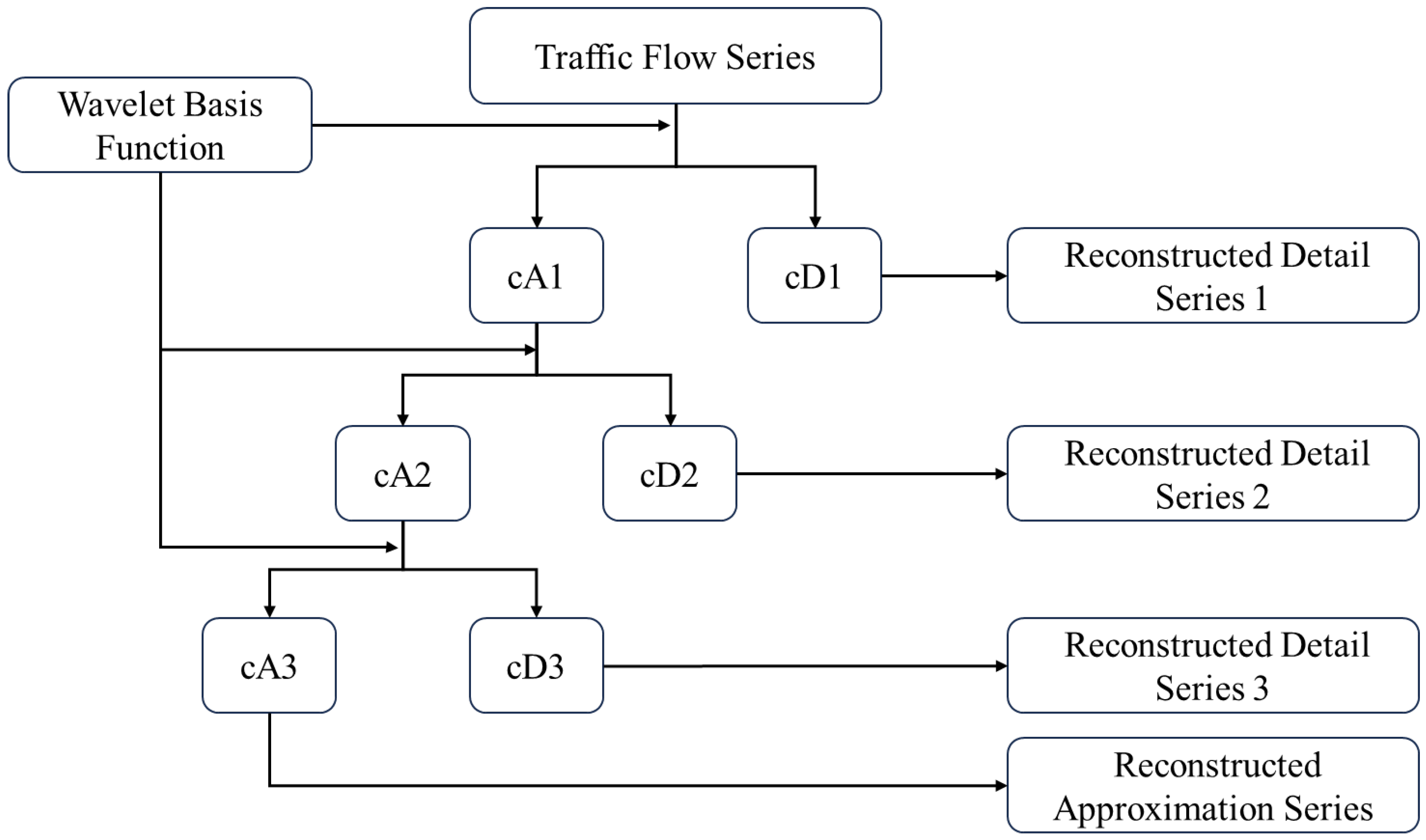
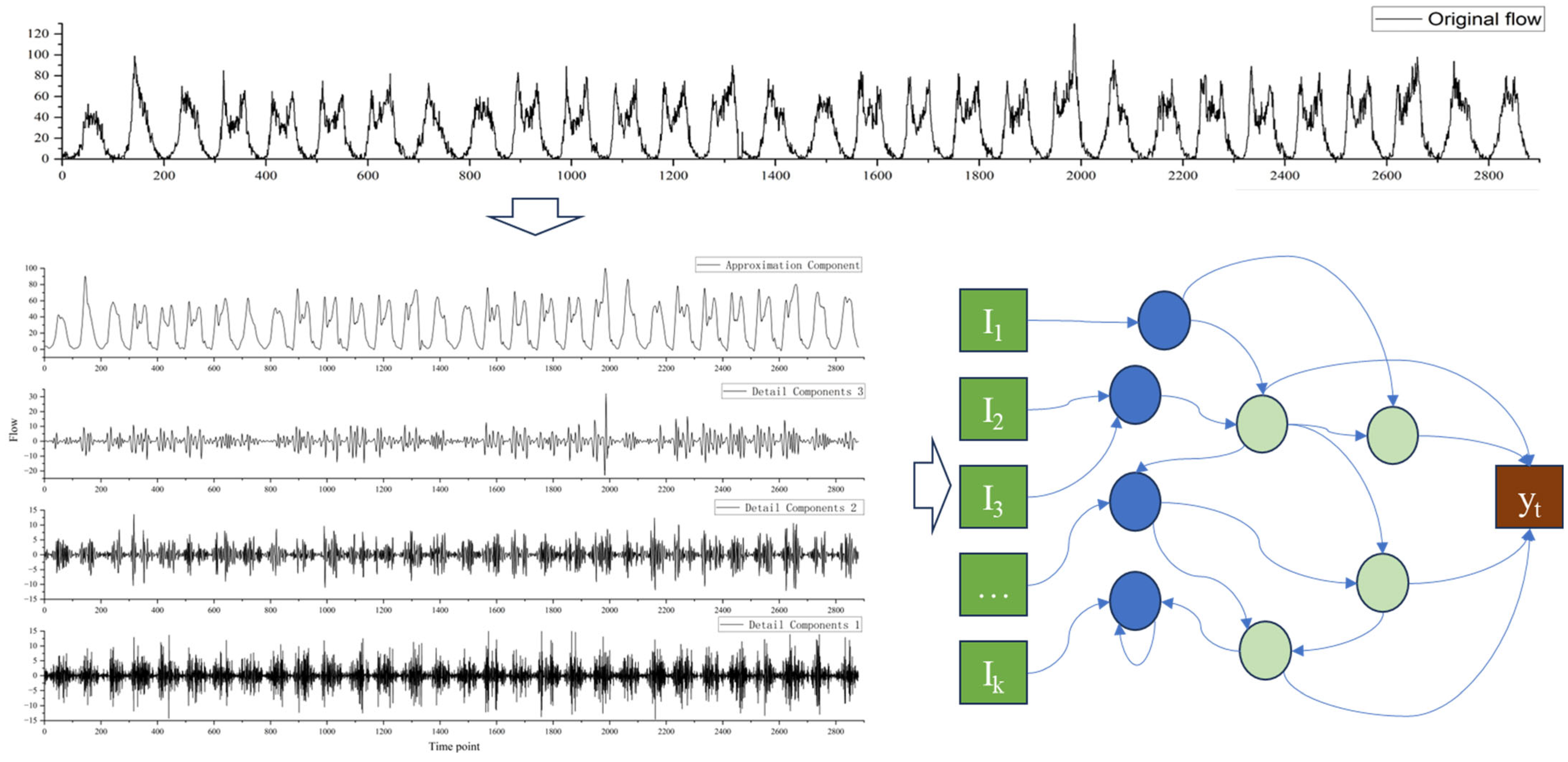


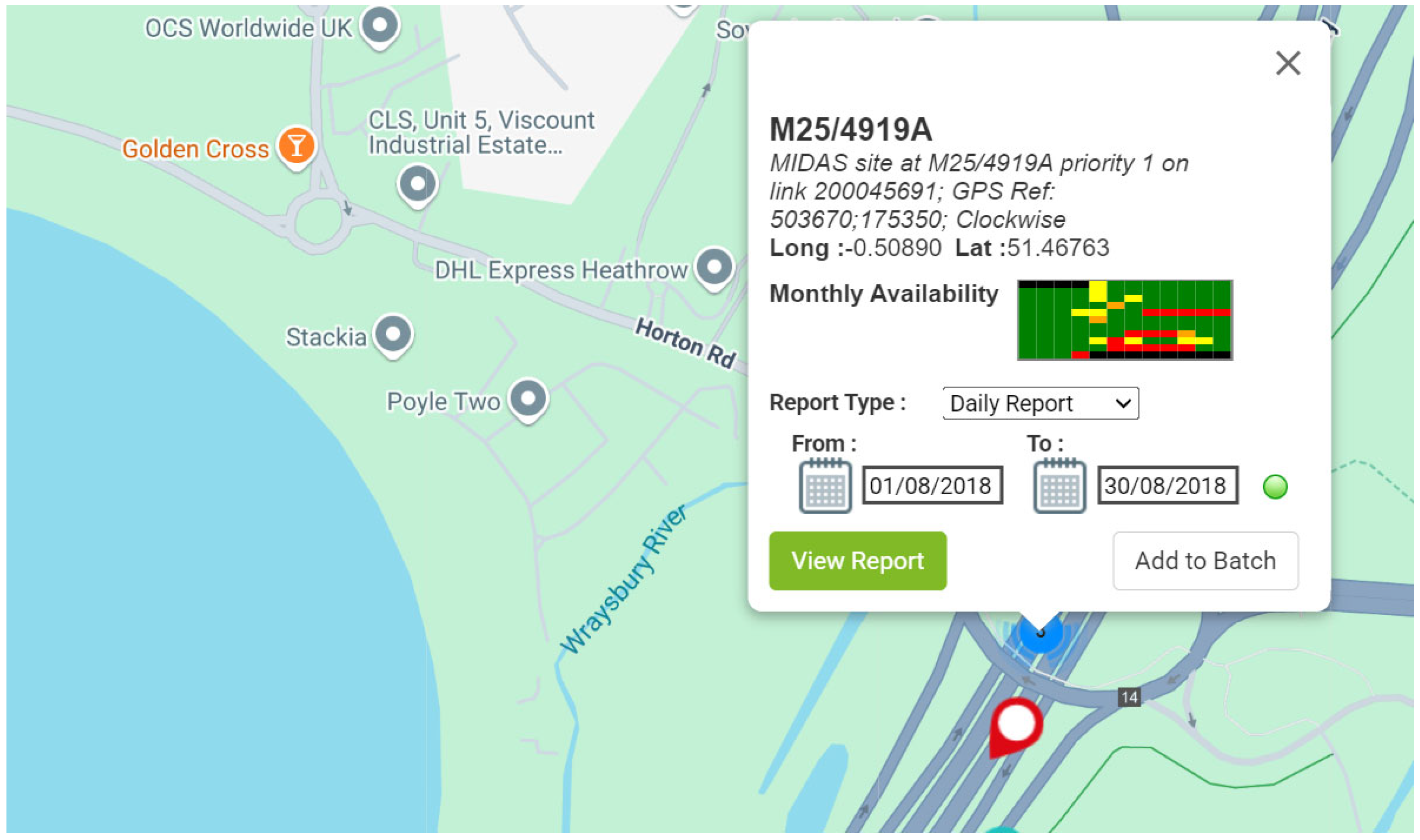
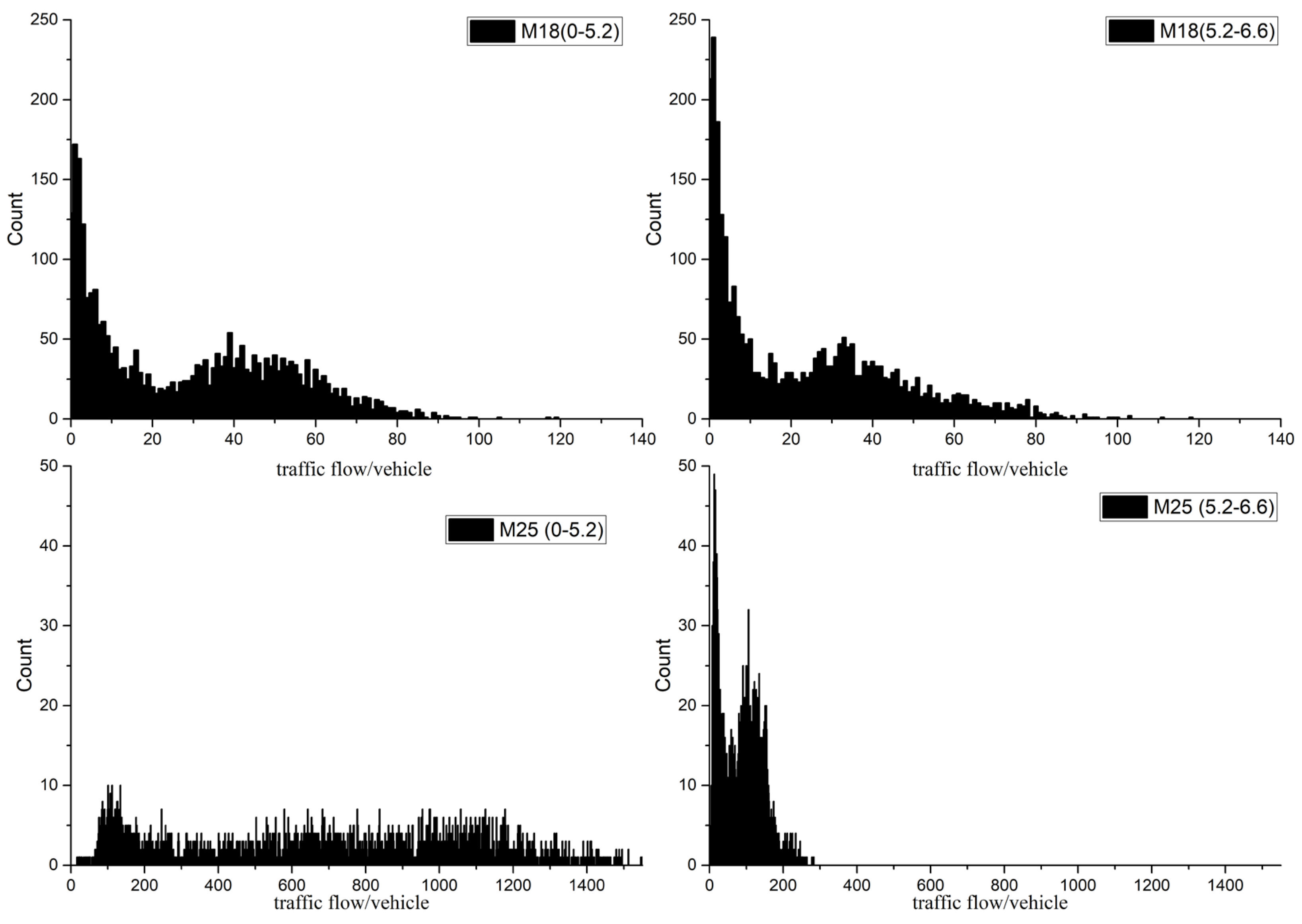

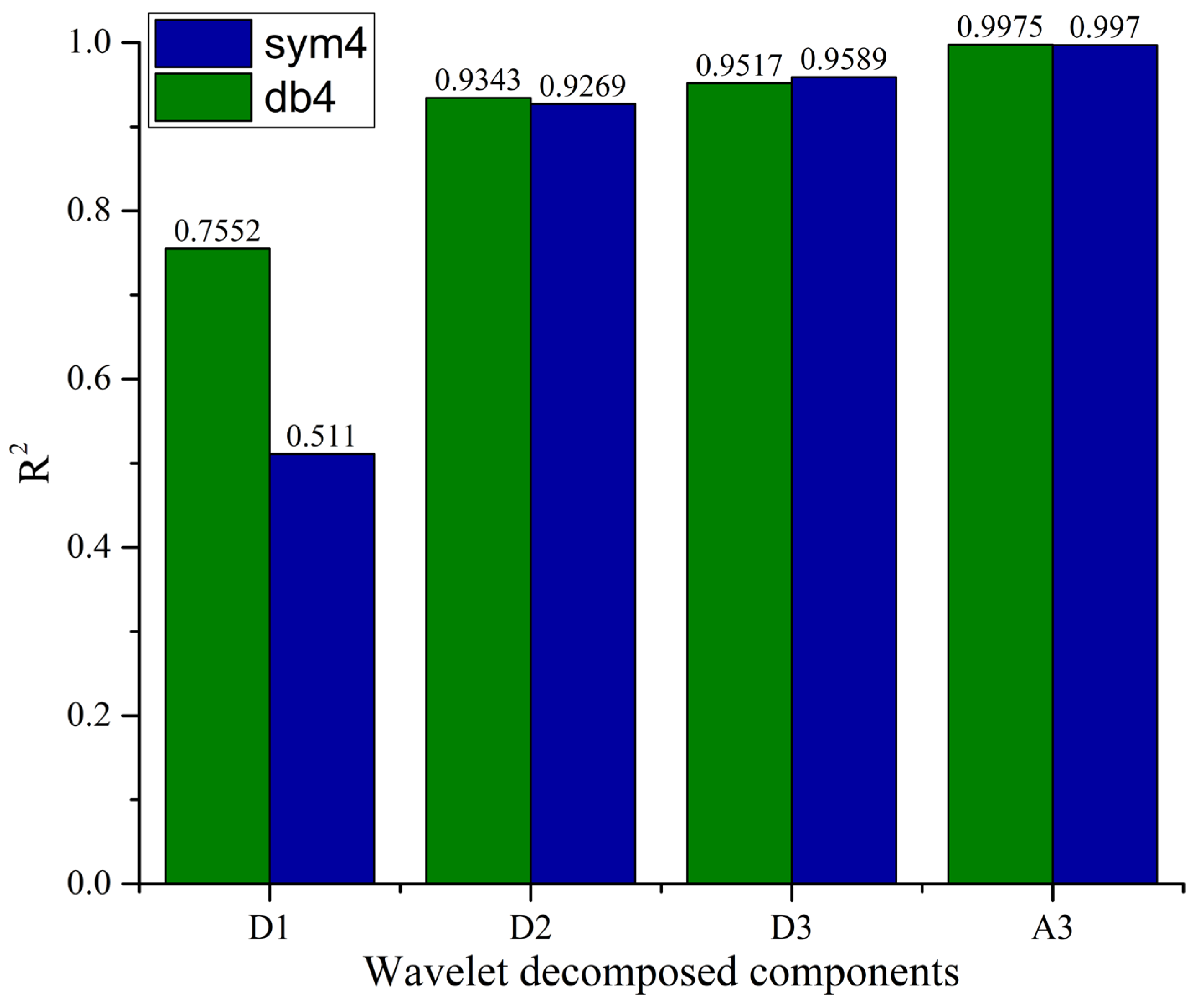

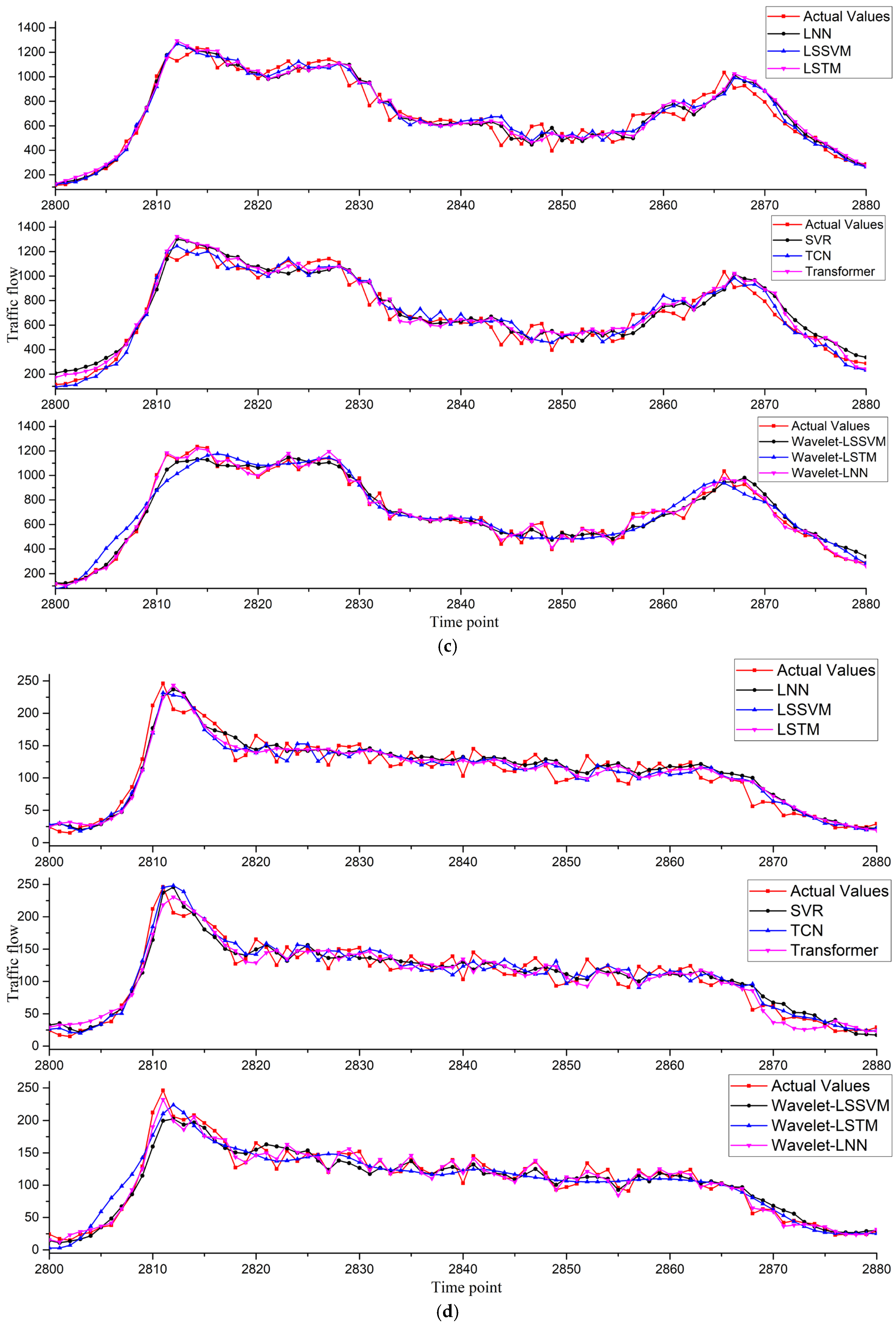
| Dataset Name | Vehicle Lengths | Time Interval | Time Range | Data Points |
|---|---|---|---|---|
| M18 (0–5.2) | 0–5.2 m | 15 min | 1 January 2022–30 January 2022 | 2880 |
| M18 (5.2–6.6) | 5.2–6.6 m | 15 min | 1 January 2022–30 January 2022 | 2880 |
| M25 (0–5.2) | 0–5.2 m | 15 min | 1 August 2018–30 August 2018 | 2880 |
| M25 (5.2–6.6) | 5.2–6.6 m | 15 min | 1 August 2018–30 August 2018 | 2880 |
| Method | R2 of db4 Wavelet Function | R2 of sym4 Wavelet Function |
|---|---|---|
| Original flow | 0.9105 | 0.9105 |
| Approximation component (A3) | 0.9975 | 0.9970 |
| Detail component 3 (D3) | 0.9517 | 0.9589 |
| Detail component 2 (D2) | 0.9343 | 0.9269 |
| Detail component 1 (D1) | 0.7552 | 0.5110 |
| Method | M18 (0–5.2) | M18 (5.2–6.6) | ||||
|---|---|---|---|---|---|---|
| R2 ↑ | MSE ↓ (Vehicle) | MAE ↓ (Vehicle) | R2 ↑ | MSE ↓ (Vehicle) | MAE ↓ (Vehicle) | |
| SVR [16] | 0.8949 | 68.254 | 6.3329 | 0.8914 | 54.5533 | 5.3725 |
| LSSVM [49] | 0.9031 | 62.9586 | 5.6119 | 0.8858 | 57.3758 | 5.0437 |
| LSTM [50] | 0.9058 | 61.2071 | 5.6254 | 0.9077 | 46.3674 | 4.5875 |
| TCN [51] | 0.8827 | 76.1518 | 3.5503 | 0.8848 | 57.8490 | 5.1027 |
| Transformer [3] | 0.8969 | 66.9624 | 5.8574 | 0.8873 | 63.6558 | 5.8198 |
| EKF [52] | 0.7997 | 130.0928 | 8.1349 | 0.7768 | 112.0995 | 7.2971 |
| LinearRegression [52] | 0.8997 | 65.1241 | 5.8392 | 0.8880 | 56.2343 | 5.2028 |
| LNN | 0.9107 | 58.0117 | 5.4603 | 0.9019 | 49.2557 | 4.7489 |
| Wavelet-LSSVM | 0.9528 | 30.6725 | 4.0256 | 0.9485 | 25.8742 | 3.5804 |
| Wavelet-LSTM | 0.9340 | 42.8779 | 4.7360 | 0.9329 | 33.7103 | 4.0539 |
| Wavelet-LNN | 0.9855 | 9.4203 | 2.1468 | 0.9825 | 8.7830 | 1.9323 |
| Method | M25 (0–5.2) | M25 (5.2–6.6) | ||||
|---|---|---|---|---|---|---|
| R2 ↑ | MSE ↓ (Vehicle) | MAE ↓ (Vehicle) | R2 ↑ | MSE ↓ (Vehicle) | MAE ↓ (Vehicle) | |
| SVR [16] | 0.9428 | 8454.3086 | 74.5208 | 0.9203 | 248.9900 | 11.8717 |
| LSSVM [49] | 0.9554 | 6590.9204 | 58.4568 | 0.9228 | 241.3882 | 11.1793 |
| LSTM [50] | 0.9523 | 7047.5994 | 61.125 | 0.9130 | 271.7080 | 11.8218 |
| TCN [51] | 0.9485 | 7606.6784 | 62.4275 | 0.9274 | 226.8570 | 10.8716 |
| Transformer [3] | 0.9429 | 8438.7593 | 71.1325 | 0.9280 | 247.4395 | 11.2920 |
| EKF [52] | 0.9139 | 12,718.9128 | 77.8814 | 0.8267 | 541.5326 | 16.3594 |
| LinearRegression [53] | 0.9457 | 8021.4953 | 66.4183 | 0.8956 | 326.286 | 12.557 |
| LNN | 0.9528 | 6965.3570 | 60.2259 | 0.9053 | 295.7774 | 12.4653 |
| Wavelet-LSSVM | 0.9736 | 3900.8762 | 49.5527 | 0.9608 | 122.4717 | 8.2329 |
| Wavelet-LSTM | 0.9568 | 6379.8590 | 59.1426 | 0.9363 | 199.0141 | 10.3825 |
| Wavelet-LNN | 0.9915 | 1252.5928 | 25.8465 | 0.9856 | 45.1464 | 4.6492 |
Disclaimer/Publisher’s Note: The statements, opinions and data contained in all publications are solely those of the individual author(s) and contributor(s) and not of MDPI and/or the editor(s). MDPI and/or the editor(s) disclaim responsibility for any injury to people or property resulting from any ideas, methods, instructions or products referred to in the content. |
© 2025 by the authors. Licensee MDPI, Basel, Switzerland. This article is an open access article distributed under the terms and conditions of the Creative Commons Attribution (CC BY) license (https://creativecommons.org/licenses/by/4.0/).
Share and Cite
Wu, Y.; Kang, H.; Wang, W.; Zhao, S.; He, X.; Chen, J. Short-Term Highway Traffic Flow Prediction via Wavelet–Liquid Neural Network Model. Modelling 2025, 6, 39. https://doi.org/10.3390/modelling6020039
Wu Y, Kang H, Wang W, Zhao S, He X, Chen J. Short-Term Highway Traffic Flow Prediction via Wavelet–Liquid Neural Network Model. Modelling. 2025; 6(2):39. https://doi.org/10.3390/modelling6020039
Chicago/Turabian StyleWu, Yongjun, Hongyun Kang, Weipin Wang, Shuli Zhao, Xuening He, and Jingyao Chen. 2025. "Short-Term Highway Traffic Flow Prediction via Wavelet–Liquid Neural Network Model" Modelling 6, no. 2: 39. https://doi.org/10.3390/modelling6020039
APA StyleWu, Y., Kang, H., Wang, W., Zhao, S., He, X., & Chen, J. (2025). Short-Term Highway Traffic Flow Prediction via Wavelet–Liquid Neural Network Model. Modelling, 6(2), 39. https://doi.org/10.3390/modelling6020039






